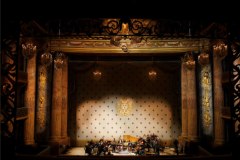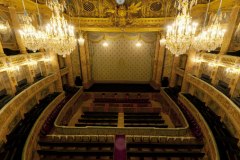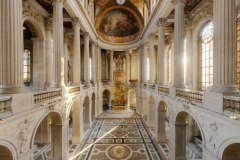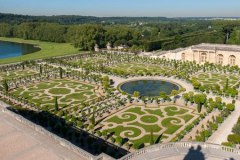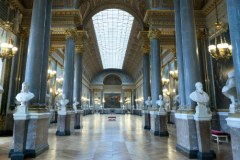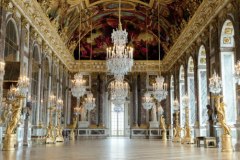Wagner: Siegfried
Mo | Tu | We | Th | Fr | Sa | Su |
Opera in three acts with libretto by Richard Wagner, first performed at Bayreuth in 1876.
Show in German with French and English surtitles
Synopsis
Act 1
Prelude to Act 1
Scene 1
A cave in rocks in the forest. An orchestral introduction includes references to leitmotifs including themes relating to the original hoard plundered by the NibelungAlberich, and one in B-flat minor associated with the Nibelungs themselves. As the curtain rises, Alberich's brother, the dwarf Mime, is forging a sword ("Zwangvolle Plage!"). Mime is plotting to obtain the ring of power originally created by his brother Alberich. He has raised the human boy Siegfried as a foster child, to kill Fafner, who obtained the ring and other treasures in the opera Das Rheingold and has since transformed himself from a giant to a dragon. Mime needs a sword for Siegfried to use, but the youth has contemptuously broken every sword Mime has made. Siegfried returns from his wanderings in the forest driving before him a large bear that terrifies Mime, and immediately breaks the new sword. After a whining speech by Mime about ingratitude, and how Mime has brought him up from a mewling infant ("Als zullendes Kind"), Siegfried senses why he keeps coming back to Mime although he despises him: he wants to know his parentage. Mime is forced to explain that he encountered Siegfried's mother, Sieglinde, when she was in labor; she died giving birth to Siegfried. He shows Siegfried the broken pieces of the sword Nothung, which she had left in his custody. Siegfried orders him to reforge the sword; however, Mime is unable to accomplish this. Siegfried departs, leaving Mime in despair ("Aus dem Wald fort in die Welt zieh’n").
Scene 2
An old man (Wotan in disguise) arrives at the door and introduces himself as the Wanderer ("Heil dir, weiser Schmied!"). In return for the hospitality due a guest, he wagers his head on answering any three questions Mime may ask. The dwarf asks the Wanderer to name the races that live beneath the ground, on the earth, and in the skies. These are the Nibelungs, the Giants, and the Gods, as the Wanderer answers correctly. When Mime still refuses hospitality, the Wanderer demands that Mime answer his three questions, or yield his own head. The Wanderer asks Mime to identify: the race most beloved of Wotan, but most harshly treated; the name of the sword that can destroy Fafner; and the person who can repair the sword. Mime can answer only the first two questions: the Wälsungs (Siegmund and Sieglinde whose tale is told in the opera Die Walküre) and the sword Nothung. Wotan tells him that only "he who does not know fear" can reforge Nothung, and abstains from taking Mime's head, leaving it for that person.
Scene 3
Mime despairs as he imagines the ferocity of the dragon Fafner, while "the orchestra paints a dazzling picture of flickering lights and roaring flames"[1] ("Verfluchtes Licht!"). Siegfried returns and is annoyed by Mime's lack of progress. Mime realizes that Siegfried is "the one who does not know fear" and that unless he can instill fear in him, Siegfried will kill him as the Wanderer foretold. He tells Siegfried that fear is an essential craft; Siegfried is eager to learn it, and Mime promises to teach him by taking him to Fafner ("Fühltest du nie im finst’ren Wald"). Since Mime was unable to forge Nothung, Siegfried decides to do it himself ("Nothung! Nothung! Neidliches Schwert!"). He succeeds by shredding the metal, melting it, and casting it anew. In the meantime, Mime brews a poisoned drink to offer Siegfried after the youth has defeated the dragon. After he finishes forging the sword, Siegfried demonstrates its strength by chopping the anvil in half with it ("Hoho! Hoho! Hohei! Schmiede, mein Hammer, ein hartes Schwert!" - Siegfrieds Schmiedelied - Siegfried's Forging Song).
Act 2
Prelude to Act 2 - Fafners Ruhe (Fafner's Rest)
Scene 1
Deep in the forest. The Wanderer arrives at the entrance to Fafner's cave, near which Alberich secretly keeps vigil by a rocky cliff ("Im Wald und Nacht"). The two enemies recognize each other. Alberich boasts of his plans to regain the ring and rule the world. Wotan states that he does not intend to interfere, only to observe. He even offers to awaken the dragon so that Alberich can bargain with him. Alberich warns the dragon that a hero is coming to kill him, and offers to prevent the fight in exchange for the ring. Fafner dismisses the threat, declines Alberich's offer, and returns to sleep. Wotan mysteriously advises Alberich that all things follow their own necessary ways which no one will change. He then rides away on his horse, leaving Alberich alone. Alberich withdraws and hides himself again in the rocks.
Orchestral Interlude
Scene 2
At daybreak, Siegfried and Mime arrive. After assuring Siegfried that the dragon will teach him what fear is, Mime withdraws. As Siegfried waits for the dragon to appear, he hears a woodbird singing from the trees (Waldweben - Forest Murmurs). He attempts to mimic the bird's song using a reed pipe, but is unsuccessful. He then plays a tune on his horn (Siegfrieds Hornruf - Siegfried's Horn Call), which unintentionally wakes Fafner in his cave. After a short exchange, they fight; Siegfried stabs Fafner in the heart with Nothung. Regretful about his own life Fafner in his last moments learns the boy's name and tells Siegfried to beware the might of the curse, which condemns every lord of the Ring to death, just as it has now brought death to him. When Siegfried withdraws his sword from Fafner's body, his hands are burned by the dragon's hot blood and he puts his finger in his mouth. On tasting the blood, he finds that he can understand the woodbird's song ("Hei! Siegfried gehört nun der Niblungen Hort!"). Following its instructions, he takes the ring and the magic helmet Tarnhelm from Fafner's hoard.
Scene 3
Outside the cave, Alberich and Mime meet and quarrel over the treasure ("Wohin schleichst du eilig und schlau"). Alberich hides as Siegfried comes out of the cave. Siegfried contemplates the ring but doesn't know what could be its use, viewing it just innocently as a valueless object of nature ("Was ihr mir nützt, weiß ich nicht"); nevertheless, on the forest bird's advice he decides to keep it. Then he complains to Mime that not even the dragon Fafner has taught him the meaning of fear. Mime congratulates him on having won his battle, and offers him the poisoned drink; however, the magic power of the dragon's blood allows Siegfried to read Mime's treacherous thoughts, and he stabs him to death ("Willkommen, Siegfried!"). Hidden nearby, Alberich is heard laughing spitefully at his brother's death. Siegfried puts Mime's body into the treasure cave and places Fafner's body in the cave entrance to block it. The woodbird now sings of a woman sleeping on a rock surrounded by magic fire ("Nun sing! Ich lausche dem Gesang"). Siegfried, wondering if he can learn fear from this woman, follows the bird towards the rock.
Act 3
Prelude to Act 3
Scene 1
At the foot of Brünnhilde's rock. The Wanderer summons Erda, the earth goddess ("Wache, Wala!"). Erda, appearing confused, is unable to offer any advice ("Männerthaten umdämmern mir den Muth"). Wotan informs her that he no longer fears the end of the gods; indeed, he wills it, because he now recognizes that through his own demise the true heritage of his life will be left to the independent pair free from envy in their love, to Siegfried the Wälsung, who took Alberich's ring without succumbing to its corrupting influence thanks to his fearlessness, and Brünnhilde (Erda's and Wotan's child), who will work the deed that redeems the World ("Dir Unweisen ruf’ ich’s in’s Ohr"). Dismissed, Erda sinks back into the earth.
Scene 2
Siegfried arrives, and the Wanderer questions the youth ("Mein Vöglein schwebte mir fort"). Siegfried, who does not recognize his grandfather, answers insolently and starts down the path toward Brünnhilde's rock. The Wanderer blocks his path, but Siegfried mocks him, laughing at his floppy hat and his missing eye, and breaks his spear (the symbol and source of Wotan's authority and power) with a blow from Nothung. Wotan, accepting his fate, calmly gathers up the pieces and vanishes ("Zieh’ hin! Ich kann dich nicht halten!").
Orchestral Interlude
Scene 3
Thanks to his fearlessness Siegfried passes through the ring of fire, emerging on Brünnhilde's rock ("Selige Öde auf sonniger Höh’!"). At first, he thinks the sleeping armored figure is a man. However, when he removes the armor, he finds a woman beneath. At the sight of the first woman he has ever seen and struck with the feeling of love, Siegfried at last experiences fear. In desperation, he kisses Brünnhilde, waking her from her magic sleep. Upon waking she hails the Sun and greets Siegfried as the World's Light ("Heil dir, Sonne! Heil dir, Licht!"). Afraid and hesitant at first to do so, Brünnhilde is eventually won over by Siegfried's love and renounces through her love for him the world of the gods and with it her own powers ("Ewig war ich, ewig bin ich"). Together, they solemnly sing praises to love, in comparison with which the glory of the gods itself seems dimmed and in which even dying can be jubilant: "radiant love, laughing death!" ("Leuchtende Liebe, lachender Tod!")
Program and cast
DOGE CATEGORY: Best seats, a free programme, an invitation to the cocktail reception (opening 45 min before the show) and unlimited champagne.
VIP CATEGORY: Best seats in house with complimentary glass of champagne and programme.
PRESTIGE CATEGORY: Excellent seats with complimentary glass of champagne and programme.
Tilmann Unger: Siegfried
Paul McNamara: Mime
Simon Bailey: Der Wanderer
Werner van Mechelen: Alberich
Hiroshi Matsui: Fafner
Melissa Zgouridi: Erda
Aile Asszonyi: Brünnhilde
Bettina Maria Bauer: Stimme des Waldvogels
Soloists, Chœur et Orchestre du Théâtre National de la Sarre
Sébastien Rouland: Conductor
Palace of Versailles Opera Theater
Royal Opera
The Royal Opera of Versailles, located in the grounds of the Castle, one of the major opera houses.
The opening of the opera house at Versailles brought to a close a process of planning, projects and designs that had lasted for nearly a century. While the Royal Opera was finally built towards the end of the reign of Louis XV, it had been envisaged since as early as 1682, the year when his predecessor Louis XIV took up residence at Versailles. The King had commissioned Jules Hardouin-Mansart and Vigarani to draw up plans for a ballet theatre. Mansart shrewdly decided on a position at the far end of the new wing that was to be built over the coming years: the nearby reservoirs for the gardens’ fountains could be used to fight any fire that might break out, while the sloping ground on that part of the site would allow provision of the necessary technical spaces below the stage without major excavation work. So cleverly-chosen, indeed, was the planned location that none of Mansart’s successors ever questioned it.
Major building work was already under way in 1685, but was soon interrupted because of the wars and financial difficulties which beset the later part of the king’s reign. Louis XV in his turn was long put off by the huge expense involved in the project. As a result, for almost a century the French court was forced to put up with a makeshift theatre installed below the Passage des Princes. When a grand opera was required, with a large cast and complicated stage machinery, a temporary theatre would be built in the stables of the Grande Ecurie, with the entire structure being demolished once the performances were over. This temporary solution was adopted, for instance, during the celebrations of the Dauphin’s wedding in February 1745, but its inconvenience was so starkly obvious that Louis XV finally resolved to build a permanent theatre, entrusting its design to his first architect, AngeJacques Gabriel.
The process of actually building the new theatre, however, was to take over twenty years. During this lengthy period of construction Gabriel, who had studied the leading theatres of Italy, in particular Vicenza, Bologna, Parma, Modena and Turin, presented a series of different designs to his royal patron, none of which was accepted. Only in 1768, faced with the forthcoming successive marriages of his grandchildren, did the king finally give the order for work to commence. Building progressed steadily and the new opera house was completed in twenty-three months, ready for its inauguration on the 16th of May 1770, the day of the Dauphin’s marriage to the Archduchess Marie-Antoinette, with a performance of Persée by Quinault and Lully.
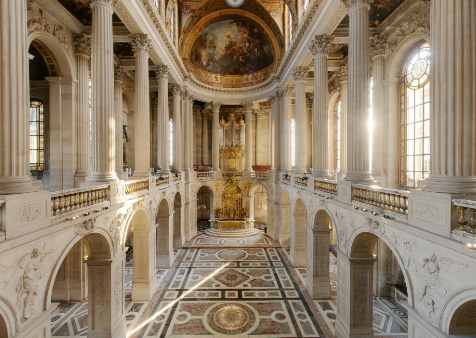
Royal Chapel
This extraordinary two-level palatine chapel was built by Jules Hardouin Mansart between 1699 and 1708 and completed by Robert de Cotte in 1710.
The paintings on the vaulted ceiling by Antoine Coypel, Charles de la Fosse and Jean Jouvenet, as well as the lavish decoration fashioned by a team of sculptors working for Louis XIV, depict a number of Old and New Testament scenes. Facing the royal gallery is the remarkable organ, created by Robert Clicquot, the King's organ builder, which was first played on Easter Sunday 1711 by François Couperin.
Even though Hardouin-Mansart did not witness the completion of the chapel, he was the one who had dictated the major aspects of the architecture and decor: a ground floor with a nave, aisles and ambulatory, and an upper floor with galleries, a harmonious combination of white and gold contrasting with the polychromatic marble floor and paintings on the vaulted ceiling, all combining to create an original space with references to both gothic architecture and baroque aesthetics.
Every day, generally at 10 a.m., the court would attend the King's mass. The King would sit in the royal gallery, surrounded by his family, while the ladies of the court would occupy the side galleries. The "officers" and the public would sit in the nave. The King would only descend to the ground floor for important religious festivals when he would take communion, for Order of the Holy Spirit ceremonies and for the baptisms and weddings of the Children of France, which were celebrated there between 1710 and 1789. Above the altar, around the Cliquot organ played by the greatest virtuosos of their age, including François Couperin, the Chapel Choir, renowned throughout Europe, would sing motets throughout the entire service, every day.
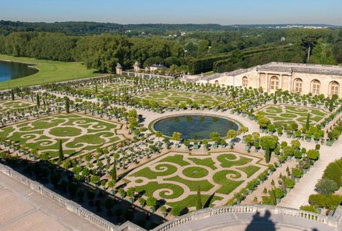
The Orangerie gardens
From May to October, orange trees and other shrubs are taken out of the Parterre Bas of the Orangerie gardens. At the center of this parterre, there is a large circular pool surrounded by six sections of lawn.
Orangerie
A great stone cathedral within a formal garden, The Orangerie is both a royal and magical place.
Built between 1684 and 1686 by Jules Hardouin-Mansart to house and protect precious trees and shrubs during the Winter, this extraordinarily large building is located beneath the parterre du Midi (South flowerbed), for which it acts as a support. Two monumental staircases, known as "les Cent Marches" (the hundred steps), frame the Orangerie's three galleries, which overlook the parterre where, during the Summer, more than 1,200 exotic trees are arranged.

 EN
EN DE
DE IT
IT FR
FR ES
ES RU
RU JP
JP RO
RO
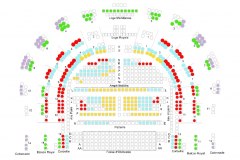 Seating plan
Seating plan 
